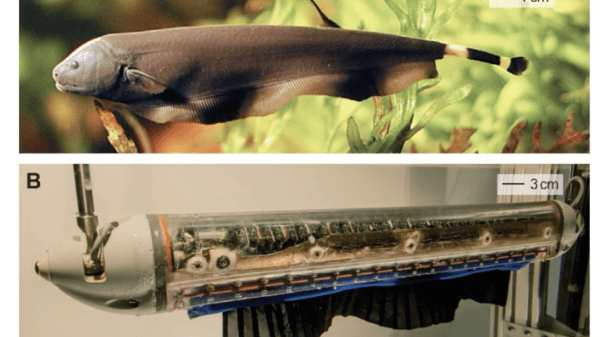Electric Fish Research Influences Biomimetic and Bio-Inspired Robotics

Research based on paper, "Kinematics of the ribbon fin in hovering and swimming of the electric ghost knifefish" by Ricardo Ruiz-Torres1, Oscar M. Curet2,*, George V. Lauder3 and Malcolm A. MacIver1.
Watch the Video Explainer for Elementary Kids
Imagine if you could feel things with electricity and swim like a pro swimmer. That's what these fish do! Scientists have made models to understand how the fish use electricity to sense things around them and how they move so gracefully in the water.
The fish have a special fin on their belly that helps them move around and swim in different directions. Engineers have created special sensors inspired by these fish that can help robots sense things in cloudy water where regular sensors can't do the job. This special sense can help robots find their way, detect objects, and explore the underwater world, just like the fish do.
Right now, researchers have been working on two different things: making fish-like fins for robots and creating sensors that can sense electricity like the fish. They've kept these two things separate to make it easier. But the real fish have both abilities working together, which is super cool!
In the future, scientists want to put both the fish-like fin and the special sensor on a robot. This could make a robot that can go to hard-to-reach places underwater and also sense things really well. It's like having a robot that can both see and swim like a champ. This could help us learn more about the underwater world and make better robots too!
Activity: Create an Electric Knifefish Robot
Objective: To explore the concept of electric knifefish and their abilities by building a simple model robot that mimics their unique features.
Materials Needed:
- Cardboard or foam board
- Small DC motors (2 per group)
- Plastic propellers (2 per group)
- Wires
- Battery pack or small batteries
- Sticky notes
- Markers
- Scissors
- Tape
- Small containers filled with water
Instructions:
-
Introduction (15 minutes): Begin the activity by discussing with the students what they know about electric knifefish and why they are interesting to scientists and engineers. Use the reworded passage to explain the basics.
-
Group Formation (5 minutes): Divide the class into small groups, ideally of 3-4 students each.
-
Design Phase (20 minutes): Instruct each group to design a simple electric knifefish robot on a piece of cardboard or foam board. They should draw the fish's body, the special fin on its belly, and two propellers on either side.
-
Build the Robot (30 minutes): Provide each group with the materials they need to build their robot. They should attach the DC motors and propellers to mimic the fish's swimming motion. Make sure they connect the wires to a battery pack to power the motors.
-
Testing (15 minutes): Allow each group to test their robot in a small container of water. Have them observe how well it moves forward, backward, and changes direction, just like the knifefish.
-
Discussion (15 minutes): Gather the class and discuss the challenges they faced during the design and testing phases. Encourage them to share their observations about how the robot's movements resemble those of an electric knifefish.
-
Wrap-up (10 minutes): Summarize the key takeaways from the activity, emphasizing the importance of studying nature to inspire and create innovative technologies.
This hands-on activity will not only help students understand the concept better but also promote teamwork, problem-solving skills, and creativity. It will give them a practical insight into the world of biomimicry and engineering.

